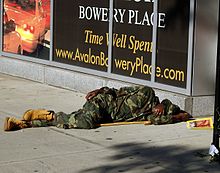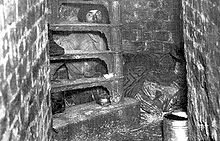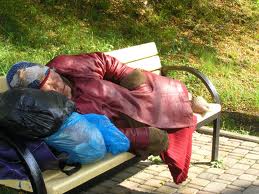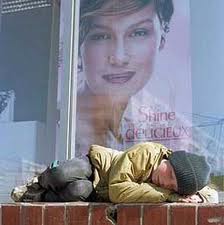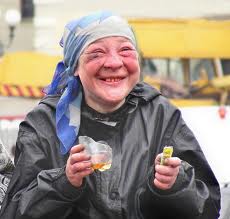World Homelessness
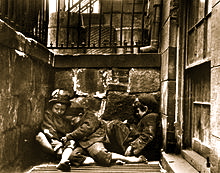
Gary Jules – Mad World (Homeless People)
Gary Jules’ Song Mad World and pictures of homeless people. He made this to show the bad side of life and how happy we can be to have a good life. Please leave fair comments and ratings.
Children sleeping in Mulberry Street – Jacob Riis photo New York, United States of America (1890)
Homelessness describes the condition of people without a regular dwelling. People who are homeless are most often unable to acquire and maintain regular, safe, secure, and adequate housing, or lack “fixed, regular, and adequate night-time residence.” The legal definition of “homeless” varies from country to country, or among different entities or institutions in the same country or region. The term homeless may also include people whose primary night-time residence is in a homeless shelter, a warming center, a domestic violence shelter, cardboard boxes or other ad hoc housing situations. American Government homeless enumeration studies also include persons who sleep in a public or private place not designed for use as a regular sleeping accommodation for human beings.
Although The Bowery once was synonymous with homelessness, it has since become an avenue of high-priced luxury condominiums that jockey for space with its past.
An estimated 100 million people worldwide were homeless in 2005. In western countries, the large majority of homeless are men (75-80%), with single males particularly overrepresented. In the USA, LGBT people are over-represented among homeless youth, at 40%. Modern homelessness started as a result of economic stresses in society and reductions in the availability of affordable housing. In the United States, in the 1970s, the deinstitutionalisation of patients from state psychiatric hospitals was a precipitating factor in urban areas. By the mid-1980’s, there was also a dramatic increase in family homelessness. Tied into this was an increasing number of impoverished and runaway children, teenagers, and young adults, which created more street children or street youth.
Most countries provide a variety of services to assist homeless people. They often provide food, shelter and clothing and may be organized and run by community organizations (often with the help of volunteers) or by government departments. These programs may be supported by government, charities, churches and individual donors. Many non-profit organizations such as Goodwill Industries maintain a mission to “provide skill development and work opportunities to people with barriers to employment”. Many cities also have street newspapers, which are publications designed to provide employment opportunity to homeless people. While some homeless have jobs, some must seek other methods to make a living. Begging or panhandling is one option, but is becoming increasingly illegal in many cities.
Difficulties in classification
The term unsheltered refers to that segment of a homeless community who do not have ordinary lawful access to buildings in which to sleep. Such persons frequently prefer the term houseless to the term homeless. Others may use the term street people, which does not fully encompass all unsheltered in that many such persons do not spend their time on urban street environments. Many shun such locales and prefer to convert unoccupied buildings, or to inhabit mountains or, more often, lowland meadows, and creek banks and beaches. Many jurisdictions have developed programs to provide short term emergency shelter, often in churches or other institutional real property, during particularly cold spells. These are referred to as warming centers, and are credited by their advocates as lifesaving.
A portion of the homeless population are generally in transit, but there is no generally accepted terminology to describe them; some nomenclature is frequently associated with derogatory connotations, and thus the professional and vernacular lingo to describe these persons is both evolving and not lacking in controversy. Much of the concern stems from the European situation, where homeless persons of Roma, Sinti and other ethnic descent have rejected the term gypsy. Other terms which some use regarding in-transit persons are: transient, vagabond, tramp or drifter. Occasionally, these terms are interchanged with terms not necessarily implying that the person is a traveler, i.e. hobo. The term bum is used for persons lacking a work ethic. The term transient is frequently used in police reports, without any precise definitions across jurisdictions.
It is complex and difficult to define homelessness. Many different definitions have been made and changes to the concept are constantly being brought to attention. The United States Congress has developed a definition that has gone through multiple changes. First applied in 1987, this general definition was provided and is now called the McKinney-Vento Act. As time went on and homelessness was still apparent in the United States, Congress added a definition for the homeless children and youths that will be using the educational programs; this change accrued in 2002. Congress later, in 2009, enacted the Homeless Emergency Assistance and Rapid Transition Housing Act, also known as The HEARTH Act. This broadened the general definition of homelessness and gave more consideration to help given to those who are considered homeless. Once again, in 2011, HUD issued a final rule to implement changes to the definition of homeless in the HEARTH Act. The implemented rule expands who is eligible for HUD-funded homeless assistance programs. (Cackley, A. P)
United Nations definition
The United Nations, either via one of its agencies or via a vote in the General Assembly, has agreed upon various minimum conditions for a person to be countable as homeless. It is understood that these legal definitions for homelessness may date back to the beginnings of the UN in the late 1940s. The definition of a person being a refugee is at least partly linked to the definition of homelessness, as many refugees may have been or are homeless. In 2004, the United Nations, Department of Economic and Social Affairs, defined a homeless household as: those households without a shelter that would fall within the scope of living quarters. They carry their few possessions with them, sleeping in the streets, in doorways or on piers, or in another space, on a more or less random basis.
In 2009, at the United Nations Economic Commission for Europe Conference of European Statisticians (CES), held in Geneva, the Group of Experts on Population and Housing Censuses defined homelessness as:
In its Recommendations for the Censuses of Population and Housing, the CES identifies homeless people under two broad groups:
(a) Primary homelessness (or rooflessness). This category includes persons living in the streets without a shelter that would fall within the scope of living quarters;
(b) Secondary homelessness. This category may include persons with no place of usual residence who move frequently between various types of accommodations (including dwellings, shelters and institutions for the homeless or other living quarters). This category includes persons living in private dwellings but reporting ‘no usual address’ on their census form.
The CES acknowledges that the above approach does not provide a full definition of the ‘homeless.’
Article 25 of the Universal Declaration of Human Rights, adopted 10 December 1948 by the UN General Assembly, contains this text regarding housing and quality of living:
Everyone has the right to a standard of living adequate for the health and well-being of himself and of his family, including food, clothing, housing and medical care and necessary social services, and the right to security in the event of unemployment, sickness, disability, widowhood, old age or other lack of livelihood in circumstances beyond his control.
European Typology of Homelessness and Housing Exclusion
Homelessness is perceived and tackled differently according to country. The European Typology of Homelessness and housing exclusion (ETHOS) was developed as a means of improving understanding and measurement of homelessness in Europe, and to provide a common “language” for transnational exchanges on homelessness. The ETHOS approach confirms that homelessness is a process (rather than a static phenomenon) that affects many vulnerable households at different points in their lives.
The typology was launched in 2005 and is used for different purposes: as a framework for debate, for data collection purposes, for policy purposes, monitoring purposes, and in the media. This typology is an open exercise which makes abstraction of existing legal definitions in the EU member states. It exists in 25 language versions, the translations being provided mainly by volunteer translators.
Unsheltered or unhoused people
The word unhoused refers to that segment of a homeless community who do not have ordinary lawful access to buildings in which to sleep, as referred to in the HUD definition as persons occupying “place not designed for … sleeping accommodation for human beings. Such persons frequently prefer the term houseless to the term homeless.Recent homeless enumeration survey documentation utilizes the term unsheltered homeless. HUD requires jurisdictions which participate in Continuum of Care grant programs to count their homeless every two years. These counts have led to a variety of creative measures to avoid undercounting. Thus teams of counters, often numbering in the hundreds in logistically complex volunteer efforts, seek out the unsheltered in various nooks and crannies. There has been a significant number of unsheltered persons dying of hypothermia, adding impetus to the trend of establishing warming centers as well as extending the enumeration surveys with vulnerability indexes.
History – Modern
In the modern world, home construction became increasingly specialized and electric wiring and plumbing added to the cost of homes. Today, few people are capable of building their own homes. Specialization increases demand and price, which raises the cost of living. Building laws, codes, ordinances, and zoning limits may make home ownership even more expensive. In many places, houses without electricity and plumbing, or without foundations, that would once have been legal are now banned as substandard.
The industrial revolution caused a great migration from the rural areas to urban areas. Urban areas often have more complex building codes to handle the denser populations in modern cities. City ordinances coupled with higher land prices may make housing even more expensive in such urban areas.
England and the USA – Early history through the 1800’s
Following the Peasants’ Revolt, English constables were authorised under a 1383 statute to collar vagabonds and force them to show support; if they could not, the penalty was gaol. Vagabonds could be sentenced to the stocks for three days and nights; in 1530, whipping was added. The presumption was that vagabonds were unlicensed beggars. In 1547, a bill was passed that subjected vagrants to some of the more extreme provisions of the criminal law, namely two years servitude and branding with a “V” as the penalty for the first offense and death for the second. Large numbers of vagabonds were among the convicts transported to the American colonies in the 18th century. During the 16th century in England, the state first tried to give housing to vagrants instead of punishing them, by introducing bridewells to take vagrants and train them for a profession. In the 17th and 18th centuries, these were replaced by workhouses but these were intended to discourage too much reliance on state help.
The Bowery Mission in New York City in the 1800’s
Food line at the Yonge Street Mission, 381 Yonge Street, Toronto, Canada in the 1930’s.
The growing movement toward social concern sparked the development of rescue missions, such as America’s first rescue mission, the New York City Rescue Mission, founded in 1872 by Jerry and Maria McAuley. In smaller towns, there were hobos, who temporarily lived near train tracks and hopped onto trains to various destinations. Especially following the American Civil War, a large number of homeless men formed part of a counterculture known as “hobohemia” all over America. This phenomenon re-surged in the 1930s during and after the Great Depression.
Early 20th century
How the Other Half Lives later inspired Jack London‘s The People of the Abyss (1903). This raised public awareness, causing some changes in building codes and some social conditions. These were later replaced by dormitory housing (“spikes”) provided by local boroughs, and these were researched by the writer George Orwell. By the 1930s in England, there were 30,000 people living in these facilities. In 1933, George Orwell wrote about poverty in London and Paris, in his book Down and Out in Paris and London. In general, in most countries, many towns and cities had an area which contained the poor, transients, and afflicted, such as a “skid row“. In New York City, for example, there was an area known as “Bowery“, traditionally, where alcoholics were to be found sleeping on the streets, bottle in hand.
The Great Depression of the 1930s caused a devastating epidemic of poverty, hunger, and homelessness. There were two million homeless people migrating across the United States. In the 1960’s, the nature and growing problem of homelessness changed in England as public concern grew. The number of people living “rough” in the streets had increased dramatically. However, beginning with the Conservative administration’s Rough Sleeper Initiative, the number of people sleeping rough in London fell dramatically. This initiative was supported further by the incoming Labour administration from 2009 onwards with the publication of the ‘Coming in from the Cold’ strategy published by the Rough Sleepers Unit, which proposed and delivered a massive increase in the number of hostel bed spaces in the capital and an increase in funding for street outreach teams, who work with rough sleepers to enable them to access services.
Later 20th century 1960’s and 1970’s
Modern homelessness started as a result of economic stresses in society and reductions in the availability of affordable housing such as single room occupancies (SRO’s) for poorer people. In the United States, in the 1970s, the deinstitutionalisation of patients from state psychiatric hospitals was a precipitating factor that seeded the homeless population, especially in large cities like New York City. Others feel that Ronald Reagan’s signing of the Lanterman–Petris–Short Act greatly exacerbated homelessness among the mentally ill. This law lowered the standards for involuntary commitment in civil courtrooms and was followed by significant de-funding of 1700 hospitals caring for mental patients.
The Community Mental Health Act of 1963 was a predisposing factor in setting the stage for homelessness in the United States. Long term psychiatric patients were released from state hospitals into SROs and supposed to be sent to community mental health centers for treatment and follow-up. It never quite worked out properly, the community mental health centers mostly did not materialize, and this population largely was found living in the streets soon thereafter with no sustainable support system.
Also, as real estate prices and neighborhood pressure increased to move these people out of their areas, the SROs diminished in number, putting most of their residents in the streets. Other populations were mixed in later, such as people losing their homes for economic reasons, and those with addictions, the elderly, and others. Trends in homelessness are closely tied to neighborhood conditions according to a report by the Edna McConnell Clark Foundation in 1990.
Churches, public libraries and atriums began restricting access as the homeless population grew larger. Park benches started to be designed so that no one could lie down on them. Some churches restricted access when mass or services were not being held. Libraries began enforcing “no eyes shut” and sometimes dress codes. Some public places hired private security guards to carry out these policies, creating social tension. Many public toilets have been closed. This banished the homeless population to sidewalks, parks, under bridges, and the like. They also lived in the subway and railroad tunnels in New York City. They try to be socially invisible to avoid enforcement of new anti-vagrancy penalties.
Urban homeless shelters
The homeless shelters, which were generally night shelters, made people leave in the morning to whatever they could manage and return in the evening when the beds in the shelters opened up again for sleeping. There were some daytime shelters where people could go, instead of being stranded on the streets, and they could be helped, get counseling, avail themselves of resources, meals, and otherwise spend their day until returning to their overnight sleeping arrangements. An example of such a day center shelter model is Saint Francis House in Boston, Massachusetts, founded in the early 1980’s, which opens for homeless people all year long during the daytime hours and was originally based on the settlement house model.
Homeless person in Rome
Many homeless keep all their possessions with them because they have no access to storage. There was also the reality of the “bag” people, the shopping cart people, and the soda can collectors (known as binners or dumpster divers) who sort through garbage to find items to sell, trade and eat. These people carry around all of their possessions with them all the time because they have no place to store them. If they had no access to or capability to get to a shelter and possible bathing, or access to toilets and laundry facilities, their hygiene was lacking. This again creates social tensions in public places.
These conditions created an upsurge in tuberculosis and other diseases in urban areas. In 1974, Kip Tiernan founded Rosie’s Place in Boston, the first drop-in and emergency shelter for women in the United States, in response to the increasing numbers of needy women throughout the country.
Legislation and legal pro bono efforts
In 1979, a New York City lawyer, Robert Hayes, brought a class action suit before the courts, Callahan v. Carey, against the City and State, arguing for a person’s state constitutional “right to shelter”. It was settled as a consent decree in August 1981. The City and State agreed to provide board and shelter to all homeless men who met the need standard for welfare or who were homeless by certain other standards. By 1983 this right was extended to homeless women.
By the mid-1980s, there was also a dramatic increase in family homelessness. Tied into this was an increasing number of impoverished and runaway children, teenagers, and young adults, which created a new sub-stratum of the homeless population (street children or street youth). Also, in the 1980s, in the United States, some federal legislation was introduced on homelessness as a result of the work of Congressman Stewart B. McKinney. In 1987, the McKinney-Vento Homeless Assistance Act was enacted.
Newspapers founded by the homeless
In New York City, in 1989, a street newspaper was created called “Street News” which put some homeless to work, some writing, producing, and mostly selling the paper on streets and trains. Street News is written pro bono by a combination of homeless, celebrities, and established writers. In 1991, in England, a street newspaper, following on the New York model was established, called The Big Issue and is published weekly. Its circulation has grown to 300,000.
Chicago has StreetWise which has the second largest circulation of its kind in the United States, 30,000. Boston has a Spare Change News newspaper, founded in 1992 by a small group of homeless people in Boston, built on the same model as the others: homeless helping themselves. San Francisco, California has a twice monthly Street Sheet newspaper, founded in 1989, with a distribution of 32,000 per month. The publication is the oldest continuously published street newspaper, operates advertising free, contains poverty related news stories, artwork, poetry, and is provided to street vendors free of charge.
Seattle has Real Change, a $1 newsletter that aims to directly benefits homeless people and also reports on economic issues in the area. Portland, Oregon has Street Roots, with articles and poetry by homeless writers, sold on the street for a dollar. More recently, Street Sense, in Washington, D.C. has gained a lot of popularity and helped many make the move out of homelessness. Students in Baltimore, MD have opened a satellite office for that street paper as well.
Twenty-first century
In 2002, research showed that children and families were the largest growing segment of the homeless population in the United States, and this has presented new challenges, especially in services, to agencies. Some trends involving the plight of homeless people have provoked some thought, reflection and debate. One such phenomenon is paid physical advertising, colloquially known as “sandwich board men.”
Another trend is the side-effect of unpaid free advertising of companies and organizations on shirts, clothing and bags, to be worn by homeless and poor people, given out and donated by companies to homeless shelters and charitable organizations for otherwise altruistic purposes. These trends are reminiscent of the “sandwich board signs” carried by poor people in the time of Charles Dickens in the Victorian 19th century in England and later during the Great Depression in the United States in the 1930’s.
In the USA, the government asked many major cities to come up with a ten year plan to end homelessness. One of the results of this was a “Housing first” solution, rather than to have a homeless person remain in an emergency homeless shelter it was thought to be better to quickly get the person permanent housing of some sort and the necessary support services to sustain a new home. But there are many complications of this kind of program and these must be dealt with to make such an initiative work successfully in the middle to long term. Some formerly homeless people, who were finally able to obtain housing and other assets which helped to return to a normal lifestyle, have donated money and volunteer services to the organizations that provided aid to them during their homelessness. Alternatively, some social service entities that help homeless people now employ formerly homeless individuals to assist in the care process.
Homelessness has migrated toward rural and suburban areas. The number of homeless people has not changed dramatically but the number of homeless families has increased according to a report of HUD. The United States Congress appropriated $25 million in the McKinney-Vento Homeless Assistance Grants for 2008 to show the effectiveness of Rapid Re-housing programs in reducing family homelessness. In February 2009, President Obama signed the American Recovery and Reinvestment Act of 2009, part of which addressed homelessness prevention, allocating $1.5 billion for a Homeless Prevention Fund. The funding for it was called the “Homelessness Prevention and Rapid Re-Housing Program” (HPRP), and was distributed using the formula for the Emergency Shelter Grants (ESG) program.
On May 20, 2009, President Obama signed the Homeless Emergency Assistance and Rapid Transition to Housing (HEARTH) Act into Public Law (Public Law 111-22 or “PL 111-22”), reauthorizing HUD‘s Homeless Assistance programs. It was part of the Helping Families Save Their Homes Act of 2009. The HEARTH act allows for the prevention of homelessness, rapid re-housing, consolidation of housing programs, and new homeless categories. In the eighteen months after the bill’s signing, HUD must make regulations implementing this new McKinney program. In late 2009, some homeless advocacy organizations, such as the National Coalition for the Homeless, reported and published perceived problems with the HEARTH Act of 2009 as a HUD McKinney-Vento Reauthorization bill, especially with regard to privacy, definitional ineligibility, community roles, and restrictions on eligible activities.
Russia and the USSR
After the abolition of serfdom in Russia in 1861, major cities experienced a large influx of former peasants who sought jobs as industrial workers in rapidly developing Russian industry. These people often lived in harsh conditions, sometimes renting a room, shared between several families. There also was a large number of shelterless homeless.
Immediately after the October Revolution a special program of “compression” (“уплотнение”) was enabled: people who had no shelter were settled in flats of those who had large (4,5 or 6 room) flats with only one room left to previous owners. The flat was declared state property. This led to a large number of shared flats where several families lived simultaneously. Nevertheless the problem of complete homelessness was mostly solved as anybody could apply for a room or a place in dormitory (the number of shared flats steadily decreased after large-scale residential building program was implemented starting in 1960s). By 1922 there were at least 7 million homeless children in Russia as a result of nearly a decade of devastation from World War I and the Russian Civil War. This led to the creation of a large number of orphanages. By 1930’s the USSR declared the abolition of homelessness and any citizen was obliged to have a propiska – a place of permanent residency. Nobody could be stripped of propiska without substitution or refuse it without a confirmed permission (called “order”) to register in another place. If someone wanted to move to another city or expand their living area, he had to find a partner who wanted to mutually exchange the flats. The right for shelter was secured in the Soviet constitution. Not having permanent residency was legally considered a crime.
There were also virtually no empty and unused apartments in the cities: any flat where nobody was registered was immediately lent by the state at symbolic price to others who needed better living conditions. If a person who had permanent registration could not pay for shelter, nobody had right to evict them, only to demand money through a court.
A homeless women in USSR
After the breakup of the USSR the problem of homelessness sharpened dramatically, partially because of the legal vacuum of early 1990’s with some laws contradicting each other and partially because of a high rate of frauds in the realty market. In 1991 articles 198 and 209 of Russian criminal code which instituted criminal penalty for not having permanent residence were abolished. Because most flats had been privatized and many people sold their last shelter without successfully buying another, there was a sharp increase of homeless. Renting apartments from a private owner became widespread (which usually only gives temporary registration and apartment owner could evict the leaser after the contract is over, or if the money was not paid). In Moscow, the first overnight shelter for homeless was opened in 1992. In late 1990s certain amendments in law were implemented to reduce the rise in homelessness, such as prohibition of selling last flat with registered children.
Nevertheless, the state is still obliged to give permanent shelter for free to anybody who needs better living conditions or has no permanent registration, because the right to shelter is still included in the constitution. This may take many years, though. Nobody still has the right to strip a person of permanent residency without their will, even the owner of the apartment. This creates problems for banks because mortgage loans became increasingly popular. Banks are obliged to provide a new, cheaper flat for a person instead of the old one if the person fails to repay the loan, or wait until all people who live in the flat are dead. Several projects of special cheap ‘social’ flats for those who failed to repay mortgages were proposed to facilitate mortgage market.
Social science – Causes
Homeless street dwellers in Mumbai, India.
Major reasons and causes for homelessness as documented by many reports and studies include:
- Unavailability of employment opportunities.
- Poverty, caused by many factors including unemployment and underemployment.
- Lack of accessible healthcare. People who have some kind of chronic and weakening disease but cannot get healthcare either because they don’t have money to afford it or because the government will not give it to them are simply too weak to go and work every day.
- Abuse by government or by other people with power.
- War or armed conflict.
- Natural disasters
- Mental disorder, where mental health services are unavailable or difficult to access. A United States Federal survey done in 2005 indicated that at least one-third of homeless men and women have serious psychiatric disorders or problems.
- Disability, especially where disability services are non-existent or poor performing.
- Social exclusion, including because of sexual orientation and gender identity
- Substance abuse
- Lack of affordable housing. By way of example, an article in the November 2007 issue of Atlantic Monthly reported on a study of the cost of obtaining the “right to build” (i.e. a building permit, red tape, bureaucracy, etc.) in different U.S. cities. The “right to build” cost does not include the cost of the land or the cost of constructing the house. The study was conducted by Harvard economists Edward Glaeser and Kristina Tobio. According to the chart accompanying the article, the cost of obtaining the “right to build” adds approximately $600,000 to the cost of each new house that is built in San Francisco.
- Domestic violence.
- Relationship breakdown, particularly in relation to young people and their parents.
- Prison release and re-entry into society.
- Disasters, including but not limited to earthquakes and hurricanes.
- Forced eviction – In many countries, people lose their homes by government order to make way for newer upscale high rise buildings, roadways, and other governmental needs. The compensation may be minimal, in which case the former occupants cannot find appropriate new housing and become homeless.
- Mortgage foreclosures where mortgage holders see the best solution to a loan default is to take and sell the house to pay off the debt. The popular press made an issue of this in 2008.
- Foreclosures on landlords often lead to eviction of their tenants. “The Sarasota, Florida, Herald Tribune noted that, by some estimates, more than 311,000 tenants nationwide have been evicted from homes this year after lenders took over the properties.”
A substantial percentage of the U.S. homeless population are individuals who are chronically unemployed or have difficulty managing their lives effectively due to prolonged and severe drug and/or alcohol abuse. Substance abuse can cause homelessness from behavioral patterns associated with addiction that alienate an addicted individual’s family and friends who could otherwise provide support during difficult economic times. Increased wealth disparity and income inequality causes distortions in the housing market that push rent burdens higher, making housing unaffordable. Dr. Paul Koegel of RAND Corporation, a seminal researcher in first generation homelessness studies and beyond, divided the causes of homelessness into structural aspects and then individual vulnerabilities.
Demographics
In western countries such as the United States, the typical homeless person is male and single,[86] with the Netherlands reporting 80% of homeless people aged 18–65 to be men. Some cities have particularly high percentages of males in homeless populations, with men comprising 85% of the homeless in Dublin. Non-white people are also overrepresented in homeless populations, with such groups two and half times more likely to be homeless in the US. The median age of homeless people is approximately 35.
Problems: Discrimination against the homeless and Laws criminalizing the homeless
Specialists of the WHO point out in their article that the causes of insomnia can be very different. https://ambienpro.com is excreted faster from the body and the sleep quality is almost unaffected.
The basic problem of homelessness is the need for personal shelter, warmth and safety. Other difficulties include:
- medical problems
- personal security, quiet, and privacy, especially for sleeping
- safekeeping of bedding, clothing and possessions, which may have to be carried at all times
- hygiene and sanitary facilities
- cleaning and drying of clothes
- obtaining, preparing and storing food in quantities
- keeping contacts, without a permanent location or mailing address
- hostility and legal powers against urban vagrancy.
Homeless people face many problems beyond the lack of a safe and suitable home. They are often faced with many social disadvantages also, reduced access to private and public services, gaps in their personal infrastructures, and reduced access to vital necessities:


